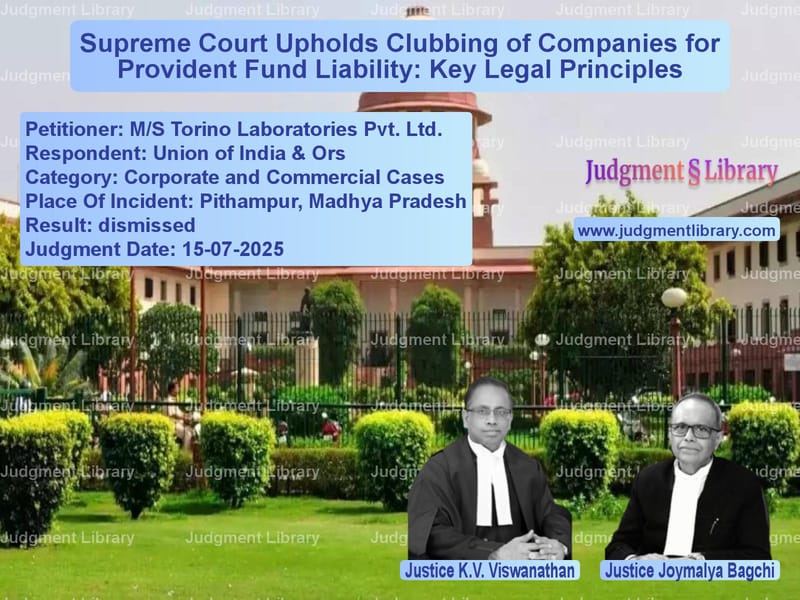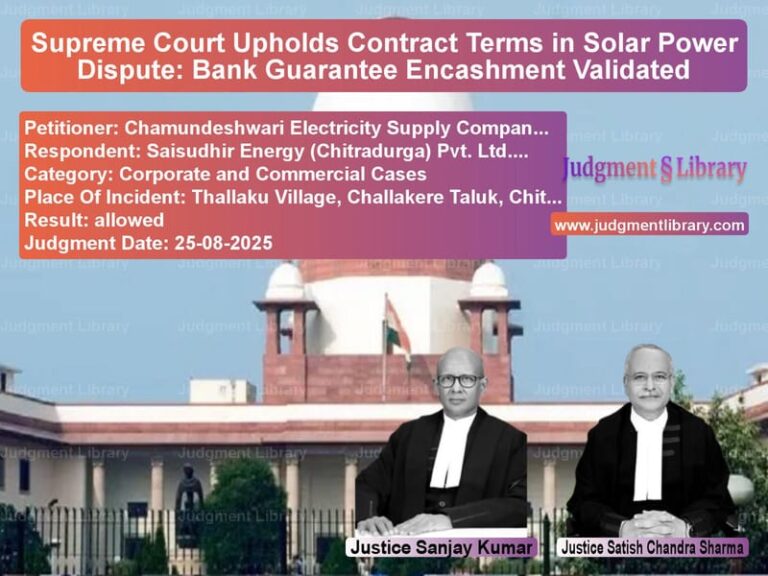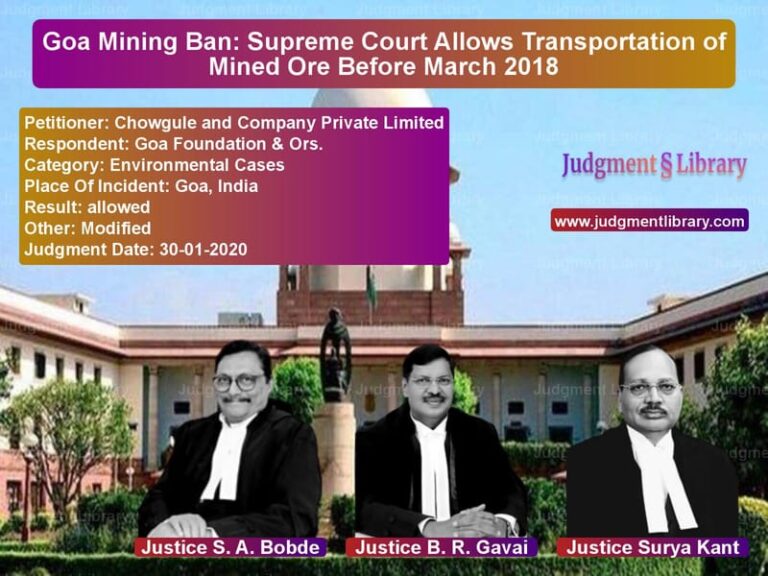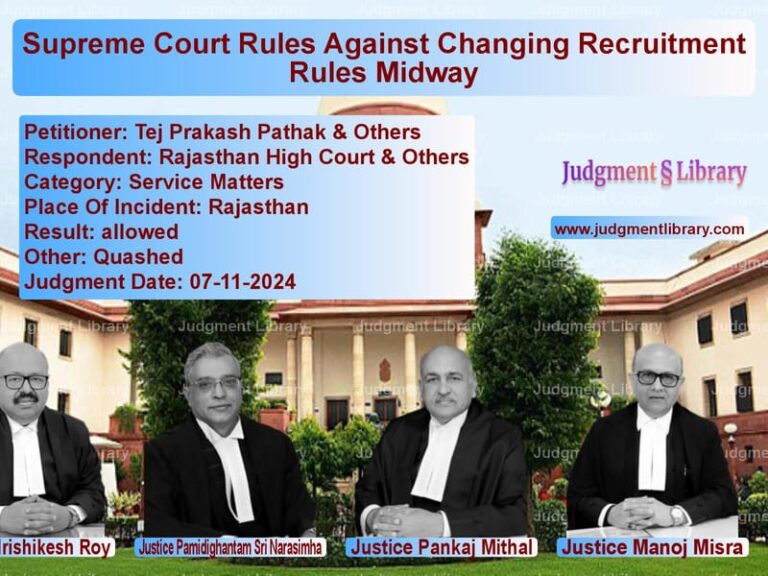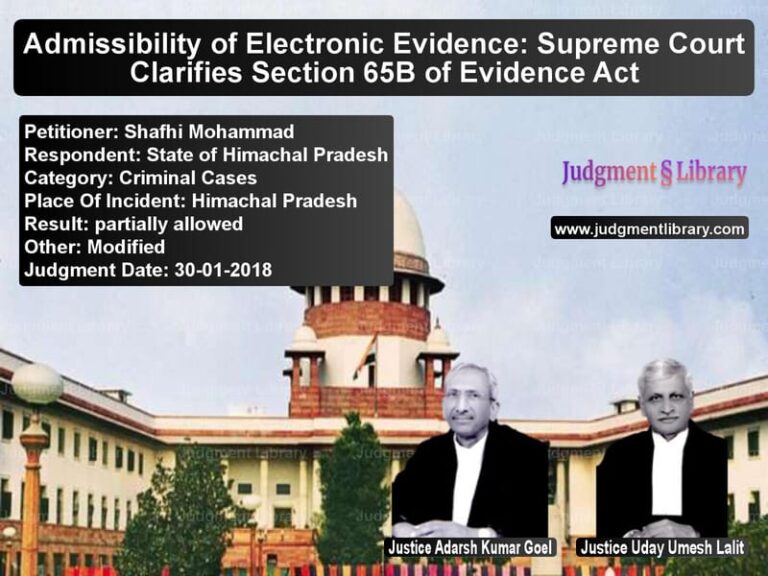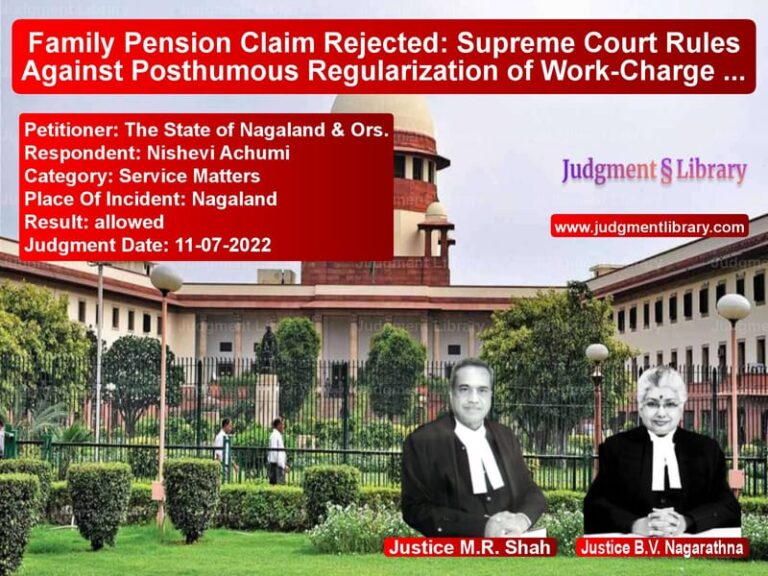Supreme Court Upholds Clubbing of Companies for Provident Fund Liability: Key Legal Principles
In a landmark judgment that clarifies the legal principles governing the clubbing of establishments under welfare legislation, the Supreme Court of India recently delivered a comprehensive ruling that has significant implications for corporate structures and employee benefits. The case involved a complex dispute between M/s Torino Laboratories Pvt. Ltd. and the Employees’ Provident Fund authorities, revolving around whether two separate companies could be treated as one establishment for the purpose of provident fund obligations.
The legal battle began when the Employees’ Provident Fund authorities sought to club Torino Laboratories with another company, M/s Vindas Chemical Industries Private Limited, both operating in the pharmaceutical sector. The authorities contended that despite separate registrations and legal identities, the two companies functioned as a single integrated unit, thereby requiring combined compliance with provident fund regulations. What followed was a protracted legal journey through multiple judicial forums, culminating in the Supreme Court’s definitive ruling that establishes crucial precedents for interpreting welfare legislation and corporate structures.
The Factual Background
The case originated from a family-owned pharmaceutical business where two brothers, Dr. Darshan Kataria and Niranjan Kataria, established Vindas Chemical Industries Private Limited in 1988 for manufacturing injections and capsules. Subsequently, in 1990, Vasudev Kataria and Smt. Rajni Kataria (wife of Darshan Kataria) incorporated Torino Laboratories Pvt. Ltd. Interestingly, Dr. Darshan Kataria also served as a director in Torino Laboratories, creating a complex web of family relationships and business interests.
Both companies operated from adjacent plots in Pithampur, Madhya Pradesh, with Vindas at Plot No. 65 and Torino at Plot No. 65/1. While Vindas was already covered under the EPF Act, the authorities sought to extend this coverage to Torino Laboratories by treating both entities as a single establishment. The inspections conducted by provident fund authorities revealed several common factors that formed the basis for their decision to club the two units.
The Appellant’s Arguments
Mr. Gagan Gupta, learned Senior Advocate for Torino Laboratories, presented multiple arguments challenging the clubbing of the two entities. He contended that “initially the Authorities proceeded on the basis of the numerical strength of the employees being in excess of 20 at the appellant’s unit and the aspect of clubbing was introduced as an afterthought.”
The appellant’s counsel emphasized the separate legal identities of the two companies, arguing that “Section 2A of the EPF Act cannot apply to two juristic entities” and that both companies were separately registered under various statutes including the Drugs and Cosmetics Act, 1940, the Factories Act, 1948, and held separate account numbers for Central Sales Tax, Central Excise, Service Tax, ESI, PAN, and Corporate Identification Numbers.
Gupta further pointed out that “the electricity and water connections for both the establishments are separate and that the Municipal Corporation Property Tax is being separately levied.” He also highlighted that there was no interchange of employees between the two units and referenced a Labour Court award dated July 21, 2010, where the stand of employees of Torino that they should be permitted to work at Vindas was rejected.
The senior counsel argued that “there was no functional integrality or interdependence between the two establishments and that while the appellant manufactures tablets and syrup, respondent No.3-Vindas manufactures injections and capsules.” Without prejudice, he contended that if the court rejected their submissions, the benefit of infancy protection should be given for the period from September 26, 1995, to September 22, 1997, under Section 16(1)(d) of the EPF Act.
The Respondent’s Counter-Arguments
Mr. Siddharth, learned counsel for the EPF Authorities, countered these submissions by emphasizing that “the question as to what constitutes an establishment is a mixed question of fact and law which ought to be answered in the context of the facts of the given case, keeping in mind the object of the statute.”
The respondents highlighted numerous common factors between the two entities: both were engaged in the pharmaceutical business; operated from the same factory premises with common entry and no visible demarcation; shared common telephone and facsimile numbers; maintained common administrative offices; used the same website and email IDs; had the same registered office; employed common security personnel; and demonstrated commonality of directors from the same Hindu Undivided Family.
The authorities argued that “the unity in management and unity in finance and the existence of common administrative/Head Office/Registered Office also pointed to the functional integrality.” They contended that “the burden to establish that there was no unity was on the appellant which the appellant failed to discharge” and that since the appellant and Vindas would be collectively assessed but liability would be only for respective employees, there was no need to issue separate summons to Vindas.
The Supreme Court’s Legal Analysis
The Supreme Court, in its detailed judgment, began by emphasizing the beneficial nature of the EPF Act, noting that “The EPF Act is a beneficial legislation intended to provide for the institution of provident funds, pension fund and deposit-linked insurance fund for employees in factories and other establishments.” The court referenced its earlier judgment in Savaji Mills Ltd. vs. Regional Provident Fund Commissioner, which held that “the EPF Act should be construed so as to advance the object with which it is passed and any construction which would facilitate evasion of the provisions of the Act should be avoided.”
The court conducted an extensive review of judicial precedents on the clubbing of establishments, starting with Associated Cement Companies Ltd. vs. Workmen, where it was held that “it is perhaps impossible to lay down any one test as an absolute and invariable test for all cases. The real purpose of these tests is to find out the true relation between the parts, branches, units etc. If in their true relation they constitute one integrated whole, we say that the establishment is one; if on the contrary they do not constitute one integrated whole, each unit is then a separate unit.”
The judgment extensively discussed Pratap Press vs. Secretary, Delhi Press Workers’ Union, where the court acknowledged that “The question whether the two activities in which the single owner is engaged are one industrial unit or two distinct industrial units is not always easy of solution. No hard and fast rule can be laid down for the decision of the question and each case has to be decided on its own peculiar facts.”
In South India Millowners’ Association vs. Coimbatore District Textile Workers’ Union, the court elaborated that “Several factors are relevant and it must be remembered that the significance of the several relevant factors would not be the same in each case nor their importance. Unity of ownership and management and control would be relevant factors. So would the general unity of the two concerns; the unity of finance may not be irrelevant and geographical location may also be of some relevance; functional integrality can also be a relevant and important factor in some cases.”
The court specifically addressed the argument that functional integrality is the sole determinative test, stating in Wenger and Co. vs. Their Workmen that “the test of functional integrality or the test whether one unit can exist without the other, though important in some cases, cannot be stressed in every case without having regard to the relevant facts of that case, and so, we are not prepared to accede to the argument that the absence of functional integrality and the fact that the two units can exist one without the other necessarily show that where they exist they are necessarily separate units and do not amount to one establishment.”
Application to the Present Case
Applying these legal principles to the facts of the case, the Supreme Court found that the APFC had correctly identified multiple common factors between Torino Laboratories and Vindas Chemical. The court noted that “the findings arrived at by the APFC that the appellant and Vindas-respondent No.3 were engaged in the same industry; they carried on business in premises built on contiguous plots of land; that they shared common telephone and facsimile numbers; they shared common website and e-mail IDs; that their Registered Office/Head Office and administrative office were the same; they have employed common security to guard the premises; that there was unity of management… that there was unity of finance inasmuch as the Hindu Undivided Family of Darshan Kataria and his family members funded both the companies, cumulatively establish beyond doubt that the two entities were rightly treated as common for the purpose of the EPF Act.”
The court made a significant observation about the burden of proof, referencing L.N. Gadodia and Sons vs. Regional Provident Fund Commissioner, where it was held that “When any fact is especially within the knowledge of any person, the burden of proving that fact lies on him. This rule (which is also embodied in Section 106 of the Evidence Act) expects such a party to produce the best evidence before the authority concerned, failing which the authority cannot be faulted for drawing the necessary inference.”
The Supreme Court firmly rejected the appellant’s contention that separate legal entities cannot be clubbed, stating that “the contention of the appellant herein that once there are two separate juristic entities, theory of clubbing cannot be invoked is completely untenable and is only stated to be rejected. It is common knowledge that artificial devices, subterfuges and facades are commonly resorted to, to create a smokescreen of separate entities for a variety of purposes. The Court of law faced with such a scenario has a duty to lift the veil and see behind applying the well-established tests to determine whether the entities are really separate entities or are they really a single entity.”
Final Ruling and Implications
The Supreme Court ultimately dismissed Torino Laboratories’ appeal, upholding the orders of the lower authorities that had clubbed the two companies for provident fund purposes. The court also rejected the appellant’s claim for infancy protection and the argument that the authorities were not justified in seeking remittance of dues from September 1995.
This judgment reinforces the principle that welfare legislation like the EPF Act must be interpreted in a manner that advances its beneficial objectives and prevents evasion through artificial corporate structures. The ruling establishes that courts must examine the substance over form when dealing with corporate arrangements that may be designed to circumvent statutory obligations towards employees.
The comprehensive analysis provided by the Supreme Court serves as an important guide for businesses, legal practitioners, and regulatory authorities in determining when separate legal entities should be treated as a single establishment for compliance with labor welfare statutes. The judgment emphasizes that no single test is determinative and that courts must consider all relevant factors cumulatively to arrive at a conclusion that serves the purpose of the legislation while preventing misuse of corporate structures.
Petitioner Name: M/S Torino Laboratories Pvt. Ltd..Respondent Name: Union of India & Ors.Judgment By: Justice K.V. Viswanathan, Justice Joymalya Bagchi.Place Of Incident: Pithampur, Madhya Pradesh.Judgment Date: 15-07-2025.Result: dismissed.
Don’t miss out on the full details! Download the complete judgment in PDF format below and gain valuable insights instantly!
Download Judgment: ms-torino-laborator-vs-union-of-india-&-ors-supreme-court-of-india-judgment-dated-15-07-2025.pdf
Directly Download Judgment: Directly download this Judgment
See all petitions in Company Law
See all petitions in Corporate Governance
See all petitions in Corporate Compliance
See all petitions in Employment Disputes
See all petitions in Contractual Employment
See all petitions in Judgment by K.V. Viswanathan
See all petitions in Judgment by Joymalya Bagchi
See all petitions in dismissed
See all petitions in supreme court of India judgments July 2025
See all petitions in 2025 judgments
See all posts in Corporate and Commercial Cases Category
See all allowed petitions in Corporate and Commercial Cases Category
See all Dismissed petitions in Corporate and Commercial Cases Category
See all partially allowed petitions in Corporate and Commercial Cases Category

